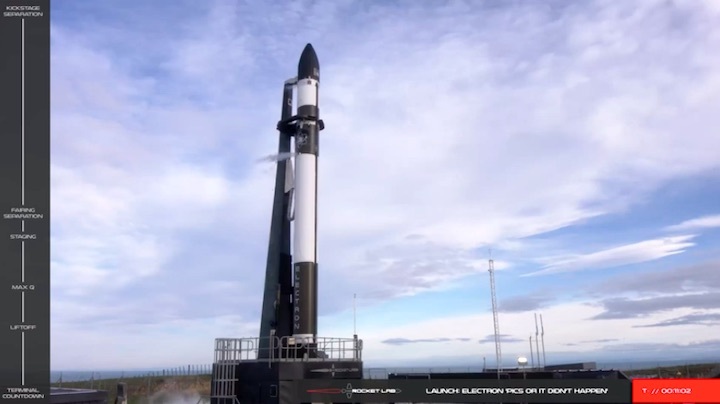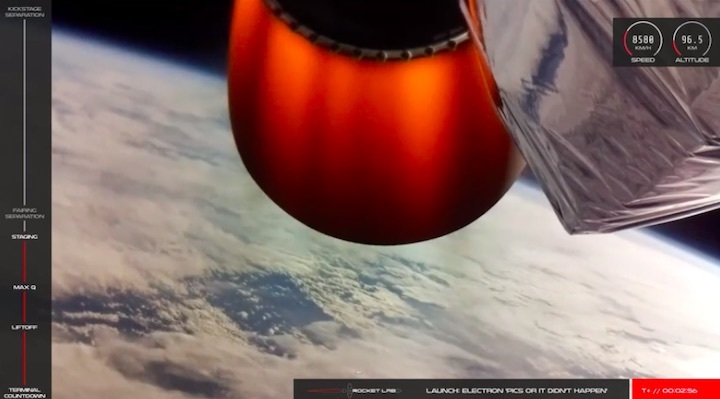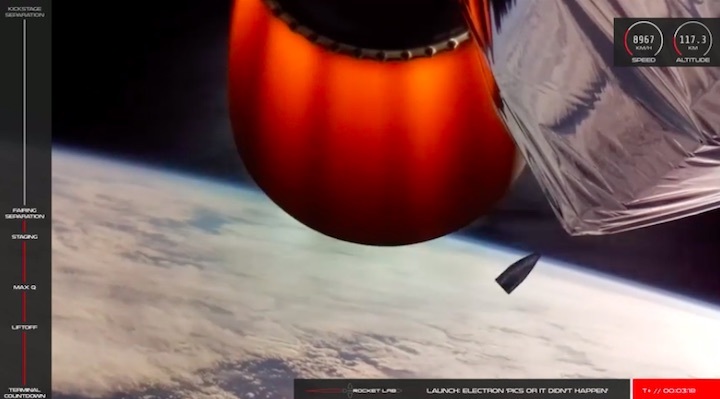4.07.2020

Rocket Lab is readying for a launch from its New Zealand spaceport Saturday (U.S. time) with seven commercial satellites from Japan, the United States and the United Kingdom, while teams at Wallops Island, Virginia, move closer to Rocket Lab’s first launch there as soon as August.
The mission Sunday will take off from Rocket Lab’s primary privately-run spaceport on Mahia Peninsula, located on the east coast of New Zealand’s North Island. The 50-minute launch window Saturday opens at 2113 GMT (5:13 p.m. EDT), or at 9:13 a.m. Sunday in New Zealand.
A forecast for high winds and heavy rain caused Rocket Lab to delay the mission from Friday to Sunday, but the company later said it would attempt a launch Saturday.
“Surprise! We’ve brought launch forward by a day as the weather is terrible through most of next week,” Rocket Lab tweeted. “Launches don’t often move to the left, but we’re going to give it our best shot. There’s still a relatively high chance we’ll need to stand down and wait for better weather though.”
Rocket Lab has nicknamed the launch “Pics Or It Didn’t Happen” in a nod to the mission of most of the payloads: Earth-imaging.
The seven satellites on-board will be deployed into a 310-mile-high (500-kilometer) sun-synchronous orbit.
Rocket Lab’s 55-foot-tall (17-meter) Electron rocket will launch the seven satellites, including the second Earth-imaging spacecraft for Canon Electronics. Named CE-SAT-1B, the 147-pound (67-kilogram) satellite is shaped like a cube, and measures a bit larger than a dorm room refrigerator.
Its imaging system will be able to resolve objects on the ground as small as about 3 feet, or 90 centimeters, according to Canon.
Spaceflight, a Seattle-based rideshare launch broker acquired by the Japanese conglomerate Mitsui last month, arranged the launch of the CE-SAT-1B spacecraft with Rocket Lab.
“This launch is very critical for Canon Electronics as we are launching a satellite where we have remarkably increased the ratio of in-house development of components compared to the previous launch,” said Nobutada Sako, group executive of Canon Electronics’ Satellite Systems Lab. “Partnering with Spaceflight on this mission has been very helpful and we look forward to a successful launch of our satellites.”
Spaceflight has also reserved capacity on a Rocket Lab Electron launch later this year for Canon’s CE-SAT-2B Earth-imaging satellite, another member of Canon’s growing fleet of spacecraft.
“We’re looking forward to getting these next generation Canon spacecraft on orbit and helping them kickstart their constellation,” said Curt Blake, CEO and president of Spaceflight. “Our ability to find the most expedient rides to space for our customers is critical, especially when their business plans require a frequent cadence of launches. Offering end-to-end launch services across multiple launch vehicles gives our customers flexibility, along with confidence that we will get them where they want to go, aligned with their schedule.”
CE-SAT-1B is Canon’s second satellite, following the launch of the CE-SAT-1 demonstration mission in 2017 aboard an Indian PSLV rocket. Canon said CE-SAT-1 carried imaging detectors based on the Canon EOS 5D Mark III and Canon PowerShot S110 cameras.
Canon says it will also test CE-SAT-1B’s imaging capabilities once in orbit, and demonstrate the satellite’s design for mass production.
Five SuperDove Earth observation nanosatellites from Planet will also ride into orbit on Rocket Lab’s Electron rocket Sunday. The SuperDoves are advanced versions of Planet’s medium-resolution Dove satellites, and are each about the size of a shoebox.
Based in San Francisco, Planet operates a fleet of more than 120 Earth observation satellites providing daily imaging coverage over all of the world’s landmass, providing data on changing features to governments and businesses. The five SuperDoves launching with Rocket Lab are part of Planet’s “Flock 4e” batch of nanosatellites.

The other payload on Rocket Lab’s next launch is Faraday 1, a CubeSat from the British company In-Space Missions. The 6U CubeSat measures about the size of a small briefcase, and is the first in a series of smallsats planned by In-Space Missions.
The Faraday line of satellites will each host multiple tiny payloads from a range of companies. Faraday 1 is packed with payloads, and will embark on a six-month demonstration mission, then enter a commercial service phase when the CubeSat will operate experiments and tech demos supplied by customers of In-Space Missions.
Airbus Defense and Space is testing a software-defined radio payload that can be remotely reprogrammed in orbit. Other payloads on Faraday 1 will pursue applications such as Internet of Things, characterization of a ground-based laser, 360-degree optical video imaging, radio spectrum monitoring, real-time video from space, and satellite-based communications, according to In-Space Missions.
“We have been working on this pioneering mission for nearly two years, from concept to this point, and can’t wait for launch,” said Doug Liddle, CEO of In-Space Missions. “It has been exciting working with such a broad spectrum of commercial customers and we were very encouraged by the diversity of the payloads on our first launch.”
The launch Saturday will be Rocket Lab’s third mission of the year, and the second in less than a month. The U.S.-based smallsat launch company has resumed flight operations in New Zealand after standing down in March due to work restrictions related to the coronavirus pandemic.
Rocket Lab said last month it is building a new Electron launch vehicle every 18 days, and is on pace to conduct monthly launches through the rest of 2020 and into 2021. After Saturday’s mission, next up for Rocket Lab will be another Electron flight from New Zealand with a radar observation craft for Capella Space, a San Francisco startup developing a fleet of commercial all-weather surveillance satellites.
Teams do not plan to attempt a controlled re-entry with the Electron booster after it’s job is done on Saturday’s launch. Rocket Lab performed two re-entry experiments on missions in December and January to gather data for future attempts to recover and reuse the Electron first stage.
An upgraded Electron booster configuration will debut later this year to begin the next phase of the recovery and reuse program.
The first Rocket Lab launch from Wallops Island, Virginia, is now third in line on the company’s flight manifest, according to Morgan Bailey, a Rocket Lab spokesperson. She said the first Electron launch from a new pad at the Mid-Atlantic Regional Spaceport — located on NASA-owned property at the Wallops Flight Facility — is expected in August or September.

Rocket Lab’s pad at Wallops is designated Launch Complex 2, while the company’s currently operating pad in New Zealand is Launch Complex 1A. A second pad on Mahia Peninsula named Launch Complex 1B is now under construction.
Rocket Lab has its corporate headquarters in Southern California, and operates two rocket factories in California and in New Zealand.
The first Electron launch from U.S. soil will deliver the Monolith research and development microsatellite into orbit for the U.S. Air Force. The mission will be managed by the U.S. military’s Space Test Program, which develops and launches scientific, experimental and technology demonstration satellites for the Defense Department.
Managed by the Air Force Research Laboratory, Monolith will demonstrate the ability for small satellites to support large aperture payloads. In the case of Monolith, the Air Force wants to test a space weather instrument package.
The STP-27RM mission with the Monolith microsatellite is an extension of the Air Force’s Rapid Agile Launch Initiative, or RALI, program. The Air Force established the RALI program to procure launch services more quickly and at lower cost than through the military’s traditional launch acquisition schemes.
Rocket Lab officials have said the Wallops launch pad will be tailored for missions with U.S. government payloads, such as military satellites and NASA missions. The other mission in Rocket Lab’s launch backlog with confirmed plans to launch from Wallops is NASA’s CAPSTONE CubeSat mission, which will head into orbit around the moon.
A dedicated Electron launch sells for as low as $7 million, significantly lower than the price of flights on larger rockets. The liquid-fueled Electron is designed to give small satellites their own ride into orbit, and is capable of lifting up to 330 pounds (150 kilograms) of payload into a 310-mile-high (500-kilometer) polar sun-synchronous orbit.
Before smallsat launch companies like Rocket Lab, CubeSats and microsatellites typically launched as secondary payloads, with their orbital destinations and launch schedules at the whim of the demands of a larger mission.
The Electron launcher for the first Rocket Lab flight from Wallops Island is currently at the Virginia spaceport. Earlier this year, engineers rolled the rocket to Launch Complex 2 and raised it vertical for the first time to begin a series of launch pad checkouts.
Rocket Lab is the second orbital-class launch provider operating at Wallops.
Northrop Grumman launches the larger Antares rocket from the facility on Virginia’s Eastern Shore on missions to resupply the International Space Station. The Minotaur rocket family, also managed by Northrop Grumman, also launches from Wallops Island.
Quelle: SN
----
Update: 5.07.2020
.






















Quelle: Rocket Lab
